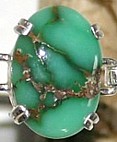
Treatment of Topaz Gems

 |
Treatment of Topaz Gems
|
 |
Topaz
occurs naturally in a wide range of colors including shades of yellow, orange, brown, pink
to Violet, and blue. With the exception of the pink to Violet shade which has color caused
by the presence of chromium, all of the other colors are caused by imperfections in the
topaz crystal called color centers. Sherry
yellow to brown tones that are commonly found in topaz crystals from both Utah and Mexico,
are unstable and on continued exposure to sunlight will completely disappear, turning the
stone colorless. In
the last 30 years or so, blue topaz, in a light shade similar to that of aquamarine, has
become a very popular gem. In fact, it’s hard to imagine the jewelry industry without
this gemstone staple, but few people know that virtually all these beautiful blue
gemstones have been treated by irradiation. Some years ago, it was discovered that
inexpensive, colorless topaz crystals could be treated by nuclear radiation and the
ionizing energy of the radiation would change the color of the topaz. The radioactive
energy slightly alters the crystal and creates a color center that gives color to the
formerly colorless crystal. Upon irradiation, the topaz first turns a brown to brown green
color. The brown tone is temporary and hides
the more desirable light blue coloration underneath. The brown tone can be removed with a
gentle heating or even upon exposure to strong sun light for several days. Once the brown
has been removed, an attractive and permanent blue coloration remains. The types of radiation used to accomplish this
change include gamma, beta (high energy electrons) and neutron radiation. Not
all of the colorless topaz takes on this blue coloration easily. Stones from Nigeria are
reputed to have the highest percentage that take on coloration easily, with stones from
Brazil also being used, but not as many will take on the blue color easily. The naturally
brown stones from Mexico and Utah will not take on the blue coloration. For some stones
gamma radiation is sufficient, for others a beta radiation is required, but nearly all
colorless stones will turn medium to dark blue upon exposure to neutron radiation. The
shade produced by neutron irradiation is deeper than the shades typically produced by
Gamma or beta irradiation. This darker neutron induced shade is sometimes called
“London” blue. The problem with neutron radiation is that it is more expensive
than the other types of treatment and it also has the potential to make the stone
radioactive as neutrons become absorbed by the impurities in the topaz. Some stones even become radioactive enough that
they present a potential safety hazard to the wearer.
These stones should not be worn. Radioactive topaz needs to be stored in a safe
environment and sometimes it takes years for the radioactivity to decay enough so that the
stone can be safely worn. |
||
| Nearly
all of the irradiation of topaz gems is done overseas, outside the country. US law
requires that all topaz treated by exposure to radiation be checked for radioactivity by a
licensed authority before it comes in to the US and is released into the gem and jewelry
trade for sale and use. Unfortunately, this
is not always done in the way required by law. In recent years, there are actually no
agencies or other authorities who are licensed by the NRC to do this checking and so none
of the large amounts of topaz which are treated overseas is currently being checked by the
legally required authority. In recent months, this has created some concern on the part of
certain consumers. While it is assumed that the gems have been checked, there usually no
documentation of this, and virtually no jewelry stores are equipped to check for
radioactivity on their own. Some jewelry stores are concerned about the potential
liability for lawsuits should a radioactive stone slip through the process and end up
being sold to a customer. Because the radiated light topaz cannot be distinguished from
natural light topaz through scientific testing, it is common that the issue of nuclear
irradiation of topaz gems is not disclosed to the buyer. However, given the current
concerns about potential radiation exposure risks, it should be to close to the buyer
especially on the sale of deeper blue colored stones which have likely been treated by
neutron radiation. This deeper blue "London" color is shown in the photo at
right in the stone on the far right.
For More information on Topaz the
gem, see my webpage at: |
|
|
|
||
Want to know a little bit more about this crazy prospector guy? Well, here's a little bit more about me, and how I got into prospecting: Chris' Prospecting Story